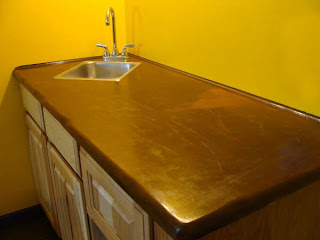How To Build Concrete Countertops
 Today’s guest post comes from Matt Smith who has been working in and around the construction industry for a few years. He specializes more in the concrete side of construction but business has slowed so now he works for Gatorback Pro Tool Belts and writes for there DIY blog.
Today’s guest post comes from Matt Smith who has been working in and around the construction industry for a few years. He specializes more in the concrete side of construction but business has slowed so now he works for Gatorback Pro Tool Belts and writes for there DIY blog.
Lately, concrete is becoming popular as a material for countertops in both kitchens and baths. It is not surprising when you consider that concrete is reasonably priced and is very versatile. With the proper care and attention to detail you can create beautiful concrete countertops in a variety of shapes and colors.
The materials for concrete countertops are inexpensive. Most of the cost in professionally installed concrete countertops is in the labor and installation costs. This makes it a tempting home improvement project for the do it your self-er. If you pay attention to detail and work carefully, you can create beautiful concrete countertops for your home.
The first step in creating concrete countertops is to build the forms. Use 3/4 inch plywood. Do not use particle board. It will soak up moisture from the concrete and swell. The forms must be built perfectly. Make sure all your corners are square, and that the form is level, and strong enough to hold the concrete. If your form gives away you will have quite a mess to clean up! You want to make the interior of your forms as non-stick as possible. This is so they will remove easily from the concrete. Some people have used exterior plywood with melamine. Put the melamine to the inside of the form. Others have lined the form with strong plastic sheeting. The problem with this method is that you must get the plastic absolutely smooth, or all the lines and creases may show up in your concrete countertop. Remember to leave space for sink inserts and such. You will not be able to cut holes easily in your concrete countertops after they dry.
After you have your forms built perfectly it is time to mix the concrete. Don’t try to mix large amounts of concrete by hand. It is worth the money to rent a small cement mixer for this project. Mix your concrete to a consistency of wet sand, like you would use to build sand castles. For strong countertops plan on using some type of support for your concrete countertop. Use a combination of diamond lath, reinforcing rod and polypropylene fibers. Pour your concrete in layers, and do not use the fiber in your top layer. It will make the countertop fuzzy!
Once the concrete is poured the real work begins. Take your time on this part. The concrete must be packed firmly into the forms. Tamp it firmly with a float, then screed it to level. Let the concrete rest for a few hours, and then trowel the surface with a steel trowel. If the surface of the concrete begins to puddle, wait for about 30 minutes and then continue troweling.
Allow your concrete countertop to cure slowly. This will result in a stronger countertop, and reduce the chances of cracking. After approximately 48 hours you can remove the forms.
There are two places in creating concrete countertops where it is really worth your time to go slow and be careful to get the best results. The first is while you are building the forms. The second is when you are finishing your countertops. Sand your countertops to a smooth finish. Don’t forget any sides that may be exposed. When the countertop is completely smooth it is important to seal it. Sealing the countertop will keep the surface from staining or picking up odors. If your countertops will be used for preparing food, make sure to use a non-toxic finish.
When it comes time to install your countertop make sure you have a lot of help available. The counter will be very heavy and you don’t want it to crack. Apply a small bead of adhesive to the base cabinet, and lower the countertop slowly. Adjust into position before the adhesive dries.
The final step, enjoy your beautiful new concrete countertops!
I’d like to Thank Matt for submitting this guest post. If you’d like to submit a guest post to Home Construction Improvement then send me an email and I’ll gladly take a look. If you’re interested in learning more about how to make concrete countertops then check out Cast-in-place Concrete Countertops: A Guide for Craftsmen.













Tempting, I tend to take on every project in the house on my own, normally to save on the labor end of costs. This is a pretty cool idea but I don’t think I’m brave enough yet even though my wife asked for new counter top in the bathroom recently.
What I would suggest is you make a small concrete countertop and really just try to get a feel for the whole process. All you really are paying for is some concrete and a few materials to build a form. Once you feel good about your smaller project you can move onto the bigger bathroom countertop.